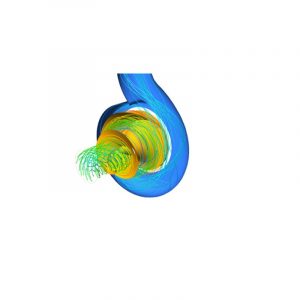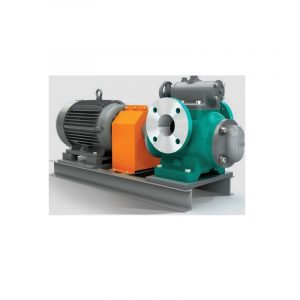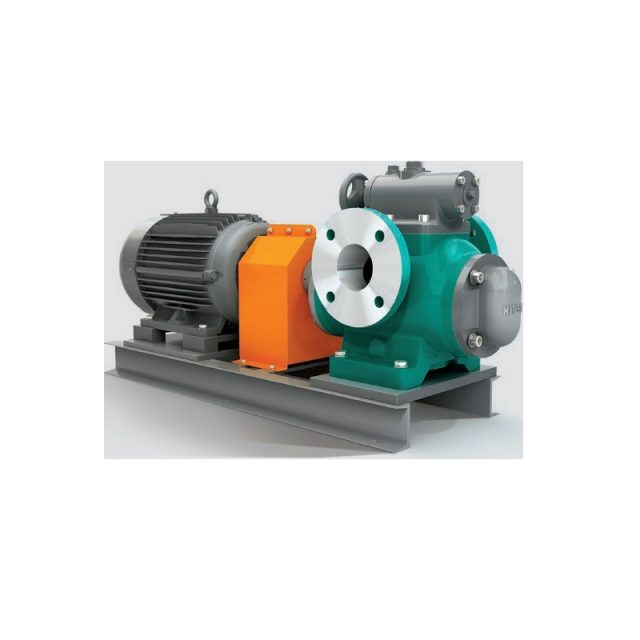Screw Pump
A screw pump is a rotary pump which is a form of a positive displacement pump and it delivers a known quantity of fluid for every revolution.
 What are the parts of a screw pump?
What are the parts of a screw pump?
A screw pump is made up of various components such as; a casing, a screw (depending on the type of screw pump; it can contain 1 screw up to 5 screws), bearings, a seal, a motor adapter and a drive shaft. Screw pumps are quite simple in construction.
How does a screw pump work?
The screw pump, as the name implies, the form of the screw is similar to a screw thread and hence by rotating it, the fluid moves along the screw thread from the suction side to the discharge side of the pump. Due to very close clearances inside the pump, the volumetric efficiency is high especially with viscous fluids as this reduces the amount of slippage of the fluid from the high pressure to the low pressure side. The pump itself like any positive displacement pump does not produce pressure, it only moves fluid but it is the actual system which produces back pressure due to friction loss.
What are the applications and uses of screw pumps?
Screw pumps are mostly used on fluids of a higher viscosity, moving these fluids with screw pumps results in energy efficient and a relatively compact machine when compared to other pump types i.e centrifugal pump. For screw pumps with more than 2 screws, they are normally used on lubricating fluids only because the screws are not geared together and are relying on the fluid to lubricate the screws.
With a twin screw pump, the screws are geared which prevent the screws contacting each other and can therefore be used on non-lubricating fluids, chemicals and food-stuffs etc Twin screw pumps are capable of a higher flow rate than higher screw pump types i.e more than 2 screws.
The main applications for a screw pump are oil based fluids, tar bitumen, adhesives (industrial type), chemicals and dairy products.
What are the different types of a screw pump?
There are various types of a screw pump depending on the number of screws – 1 screw up to 5 screw variations with the 2 screw pump (also called the twin screw pump) being the most common where the gears must be together to prevent contact. The twin screw pump can be fairly forgiving in terms of being able to handle entrained air or gas, including slugs of gas, whereas the 3 screw pumps cannot be used in this instance as there is a real chance that the screw would touch together.
When there is more than 1 screw involved, it is often referred to a Multi screw pump. The construction is relatively simple and is capable of a higher flow rate. They can also be used in self-priming applications with the correct suction piping configuration.
How does a multi screw pump work?
What is the difference between screw pumps vs gear pumps?
Screw pumps are capable of much higher flows and pressures compared to gear pumps. Gear pumps limit are 250m3/hr up to 16 bar whereas a twin screw pumps limit is 500m3/hr up to 16 bar and a 4 screw pumps limit is 1500m3/hr up to 80 bar. Gear pumps work by intermeshing gears with external or internal type.
As gear pumps are virutally “single stage positive displacement” pumps with less pressure capability than screw pumps. Screw pumps have a longer screw where the pressure is divided along the length of the screw. A twin screw pump has a much greater ability of handling solids whereas a gear pump is restricted to clean fluids.
What is the difference between a screw pump vs centrifugal pump?
Screw pumps delivers a known quantity of fluid for every revolution whereas the Centrifugal pump is dependent on the system conditions which in turn may affect the flow rate. Due to the volumetric efficiency of screw pumps, they will usually require less energy i.e. smaller motor when compared to a centrifugal pump on the same application.
Screw pumps depend heavily on the close internal clearances being maintained t o remain efficient. There is no clearance adjustment facility on screw pumps whereas Centrifugal process pumps will usually have an impeller adjustment facility so it can restore the running clearance. Screw pump parts are inherently self-priming whereas Centrifugal pumps would require a priming system, foot valve or self-priming casing design.

How we can help you?
Flexachem are the leading distributors for the sizing & design of NETZSCH Screw Pumps in Ireland. We offer a wide range of Screw Pumps including the twin screw pump and Multi Screw Pumps for both the Chemical and Process Industries.
We provide localised technical support & on-site service engineering to support your needs. We also hold a heavily stocked inventory to help take the pressure off you in the event of unexpected emergencies.
Have any questions around the selection of our Screw pump range – why not speak directly to one of our Pump Specialist Team?
Contact our Pump Specialist Team:
Phil Soltan (External) – mob: 086 185 3782
Internal Team
Adrian McSweeney – tel: 021 461 7212
Paul-Fox Morris – tel: 021 461 7231
Una Long (Pump & Service Support) – tel: 021 431 7200
Tel: 021 4617 200

 What are the parts of a screw pump?
What are the parts of a screw pump?